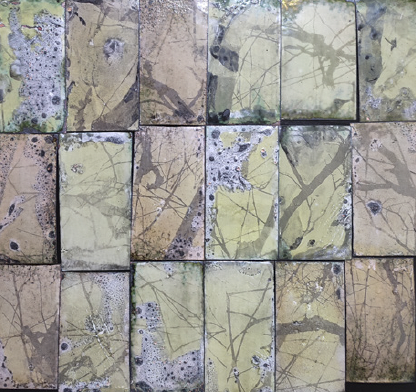Abstract
The concept of displacement and its consequences are permanently present in my practice, either in the narratives explored in light of the personal stories that have a wider psychological impact, or in the archaeological approach to tame raw, organic materials through the reconstitution of technological, 19th-century procedures considered obsolete and commercial. The approach to paper based on multiple experiments led to reconstructing feasible alternatives to the traditional techniques of obtaining images, including photographic and non-photographic processes. Revision of gillotage, reconstruction of lithographic drawing, painting and printing tools and working in situ directed the research into more immediate work with raw materials like resins, plasters, organic glues, and pigments. Preliminary tests of image development with dichromate dusting methods established satisfactory surfaces for traditional photo-enamel. In my PhD proposal, displacement meets with the obsolete techniques and the fusion of printmaking, photography, and glass as a haptic medium that corresponds to my heuristic approach.
References
Baudelaire, Charles (1863). The Painter of Modern Life, Phaidon Press.
Bron A. (2000). Floating as an Analytical Category in the Narra tives of Polish Immigrants to Sweden, [w:] E. Szwejkowska-Olsson, M. Bron Jr (red.) Allvarig debatt och rolig lek. En festskrif tillagnad A. Nils Uggla, Upp sala University.
Foucault, M. (1988). Madness and Civilization: A History of Insanity in the Age of Reason. Vintage; 1 edition.
Freud, S. (1911-1913). The Complete Psychological Works of Sigmund Freud: “ The Case of Schreber “ Papers on Technique. Volume 12, Vintage; New Ed edition (2001).
Fromm, E. (1968). The revolution of hope: toward a humanized technology. American Mental Health Foundation Books (October 26, 2010).
Gascoigne, B. (2004). How to Identify Prints: A Complete Guide to Manual and Mechanical Processes from Woodcut to Inkjet. Thames & Hudson Ltd, England.
Gernsheim, H. (1986). A Concise History of Photography. Dover Publications, New York.
Harker, M.F. (1982). Victorian and Edwardian Photographs, Littlehampton Book Services Ltd., London, England.
Jakubik, A. Piaskowska, K. (2000). Osobowość alienacyjna a schizofrenia paranoidalna, Studia Psychologica UKSW, Available at: http://bazhum.muzhp.pl/media/files/Studia_Psychologica/Studia_Psychologica-r2000-t-n1/Studia_Psychologica-r2000-t-n1-s69-80/Studia_Psychologica-r2000-t-n1-s69-80.pdf.
Larry J. Schaaf, (2000): The Photographic Art of William Henry Fox Talbot. Princeton University Press, United Kingdom. (P.14)
Petrie, K. (2011). Ceramic Transfer Printing. A&C Black (Bloomsbury Publishing). London, England.
Reff, Theodor (1976). Degas: The Artist’s Mind, Metropolitan Museum of Art; Harper & Row, Publishers; First Edition.
Schreber, D. P. (1903). Memoirs of My Nervous Illness. New York: New York Review of Books, 2000.
Seeman, M. (1959). On the meaning of alienation. American Sociological Review, 24,783-791.
Seeman, M. (1975). Alienation studies. Annual Review of Sociology, 23, 91-123. Van Gennep, A. (2019). The Rites of Passage. University of Chicago Press, Chicago. (1st edition 1909).
Weiss, R. S., Riesman, D., and Bowlby, J. (1973) Loneliness: The experience of emotional and social isolation. Cambridge University Press.

This work is licensed under a Creative Commons Attribution 4.0 International License.
Copyright (c) 2024 Marta Bełkot
